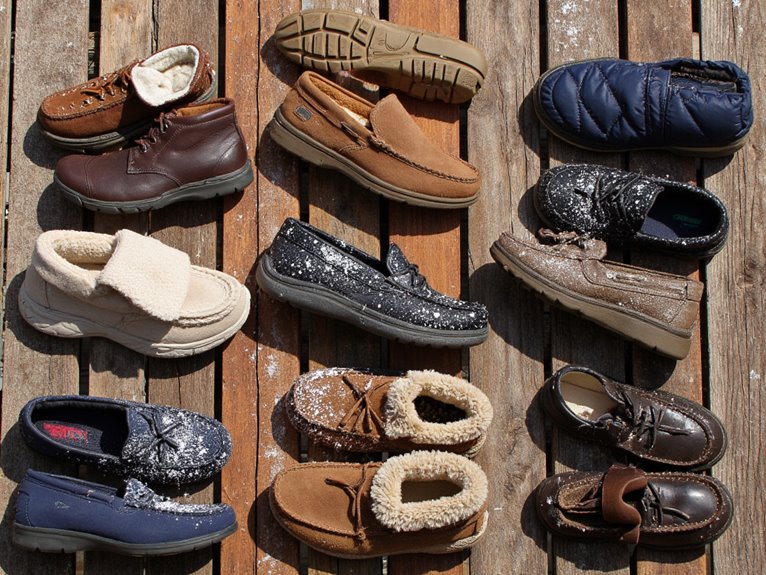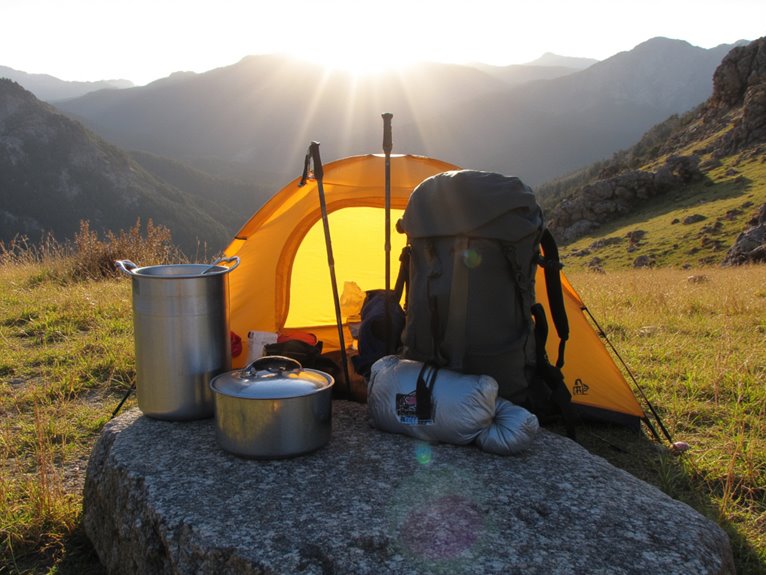How Do I Get Into a Canadian Canoe?
To get into a Canadian canoe safely and efficiently, prepare the canoe by verifying it's stable and parallel to shore or dock, with the center seat directly in front of you. Choose a shallow water entry point with gradual incline and minimal vegetation. Position yourself parallel to the canoe's centerline, with your dominant foot forward and facing the water. Take a slow and deliberate step into the canoe, keeping your weight centered and arms out for balance. Finally, prioritize your center of gravity and maintain three points of contact as you settle into your seat, and you'll be ready to launch – but there's more to discover to guarantee a smooth and enjoyable ride.
We are supported by our audience. When you purchase through links on our site, we may earn an affiliate commission, at no extra cost for you. Learn more. Last update on 28th December 2025 / Images from Amazon Product Advertising API.
Prepare Your Canoe for Entry
Before stepping into your canoe, verify it's properly positioned and stable by facing the canoe directly, with the center seat or yoke directly in front of you.
Confirm the canoe is parallel to the shore or dock, and the water is calm. Hold the gunwale or a stable part of the canoe for support.
Check the canoe's trim, making sure it's evenly balanced and not listing to one side. This will prevent unexpected shifts in weight during entry.
Finally, take a moment to mentally prepare yourself for entry, focusing on your center of gravity and balance.
Verify that you have taken all necessary precautions to guarantee a stable canoe. Properly preparing your canoe for entry sets the stage for a safe and enjoyable paddling experience.
Choose the Right Entry Spot
When choosing the right entry spot for your Canadian canoe, consider the water's edge carefully.
Opting for shallow water, the side of a dock, or the middle of a shore can make all the difference in a safe and successful entry.
Shallow Water Entry
In the pursuit of a serene paddling experience, selecting a shallow water entry point with a stable and firm lake or riverbed is essential to avoid getting stuck or damaging your canoe.
A shallow water entry point allows you to wade into the water and step into the canoe with confidence.
Look for areas with a gradual incline, minimal vegetation, and a solid bottom.
Avoid areas with loose rocks, weeds, or muddy bottoms that can make it difficult to balance or get stuck.
Side of the Dock
Stepping onto the side of a dock can be a convenient and accessible way to enter your canoe, as long as you choose a spot with a stable and secure platform to support your weight.
When selecting a dockside entry point, consider the following:
Dock stability: Verify that the dock is securely anchored and can support your weight.
Canoe positioning: Position your canoe parallel to the dock, with the center of the canoe aligned with the dock's edge.
Foot placement: Place your feet shoulder-width apart on the dock, with one foot near the canoe's center and the other near the dock's edge.
Middle of Shore
When launching from the middle of the shore, it's essential to choose the right entry spot.
Your entry spot on the middle of the shore should be a firm, flat area with good traction, allowing you to maintain balance and stability as you get into your canoe.
Avoid areas with loose gravel, sand, or slippery rocks that could cause you to slip or lose your footing.
Look for a spot with compacted earth or a flat rock that provides a stable surface.
This will give you the confidence to step into your canoe with ease, ensuring a safe and enjoyable paddling experience.
Take your time, and don't rush the process – a little extra caution can go a long way in preventing accidents.
Position Yourself for Entry
Positioning yourself parallel to the canoe's centerline, with your dominant foot forward and your body facing the water, allows for a stable and balanced entry. This stance enables you to maintain equilibrium while getting in and out of the canoe.
Three essential considerations to keep in mind:
- Keep your weight centered: Avoid leaning forward or backward, as this can cause the canoe to tip.
- Face the water: This allows you to maintain a clear line of sight and react quickly to any changes in the water.
- Bend your knees: This will help you maintain balance and stability as you step into the canoe.
Step Into the Canoe Safely
With your body positioned parallel to the canoe's centerline, take a slow and deliberate step into the canoe with your dominant foot, keeping your weight centered over the boat.
As you step in, keep your knees slightly bent to lower your center of gravity. This will help you maintain balance and stability.
Make sure to keep your arms out to the sides for balance and support.
Avoid sudden movements, as they can cause the canoe to tip. Instead, move slowly and deliberately, keeping your weight centered and your body balanced.
Balance and Stabilize the Canoe
When balancing and stabilizing the canoe, it's essential to prioritize your center of gravity, keeping it low and centered over the boat.
This can be achieved by maintaining three points of contact with the canoe, whether that's two hands and one foot or two feet and one hand.
Center of Gravity
Maintaining a low center of gravity is essential to balance and stabilize the canoe, as it directly affects the boat's stability and responsiveness to paddle strokes.
To achieve this, focus on the following key elements:
Weight distribution: Keep your weight centered over the canoe, avoiding leaning to one side or the other.
Seating position: Sit comfortably with your knees slightly bent, back straight, and feet shoulder-width apart.
Gear placement: Store gear in a way that distributes weight evenly throughout the canoe, avoiding heavy concentrations at either end.
Maintain Three Points
As you settle into your canoe, focus on establishing three points of contact to achieve ideal balance and stability.
This vital step guarantees a smooth and enjoyable paddling experience.
Sit comfortably with your feet shoulder-width apart, and position your knees slightly bent.
Establish three points of contact by placing your feet firmly on the floor, your buttocks on the seat, and your hands gripping the gunwales.
This tripod-like stance distributes your weight evenly, granting you stability and balance.
Move to Your Seating Position
With your paddle securely in hand, step into the canoe and make your way to the seat, keeping your center of gravity low and your weight evenly distributed between both feet.
As you move to your seating position, maintain a steady pace and avoid sudden movements that could tip the canoe.
To facilitate a smooth shift, follow these guidelines:
- Keep your knees slightly bent to lower your center of gravity.
- Place your hands on the gunwales for support, if needed.
- Slide onto the seat slowly, keeping your weight centered.
Final Check Before Launch
Before pushing off from the shore, perform a final check to verify your canoe is properly prepared for launch.
Confirm the canoe is floating evenly, with the bow and stern at the same height.
Check that the seats are securely attached, and the footrests are adjusted to fit your leg length.
Verify that the paddles are securely stored and within easy reach.
Also, double-check that you have all necessary safety gear, such as a properly fitting life jacket, a whistle, and a first-aid kit.
A thorough final check will give you peace of mind and guarantee a safe and enjoyable paddling experience.



